Habitat Gardening: The Basics
As you have no doubt noticed in your own gardens, summertime wildlife is everywhere right now! Fawns have been born, chipmunks are out causing trouble, many of the nesting birds have fledged, the hummingbirds are out in force (the males, anyway; the females are currently sitting on nests in our area), and if you have as many violets as we have here at Toadshade, you likely have a number of fritillaries playing butterfly games in your yard. So how do you support such a wide variety of species? After all, a turtle requires different things than a hummingbird... or does it?
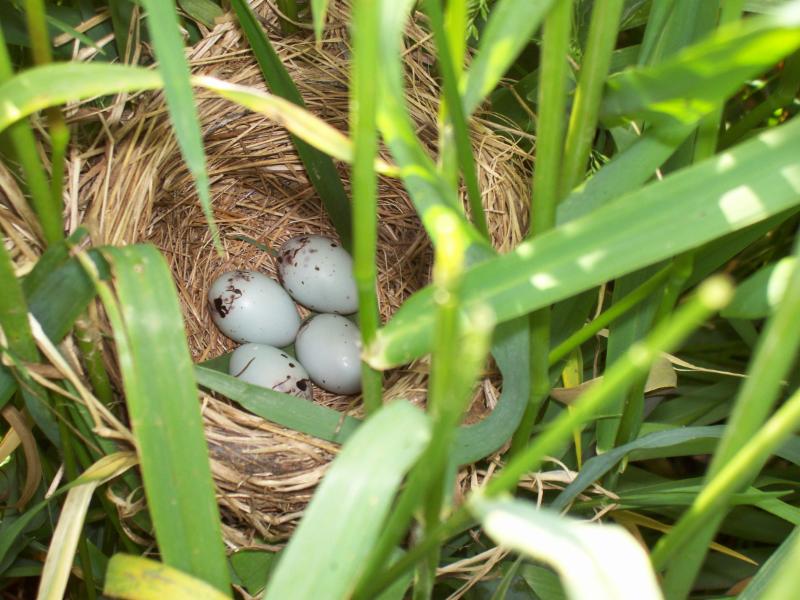
Red-winged Blackbird nest (Agelaius phoeniceus) in tall grass
Habitat Layers: What does Wildlife Need?
Most wildlife species have at least a few needs in common: they all need a place to shelter, they all need food, and they all need access to water. A great deal of modern landscaping includes few to none of these things, which is directly related to why some gardens have significantly higher rates of animal biodiversity as compared to others. Butterflies need a place to go at night, birds need to be able to find shelter when a hawk flies over, and all wildlife species need to be able to access food and water sources. So while turtles and hummingbirds may not use the same parts of your habitat garden, creating a garden in which all of these things are available will attract not only these two species, but everything in between, as well. If you imagine a forest with a canopy, understory, and leaf litter, that's essentially what you're going for in your garden, only on a smaller-scale. The upper layer (much like a canopy) allows songbirds to hide from predators and browse on insects. The middle layer (analogous to an understory) has the same effect, and creates shelter for butterflies at night and moths during the day (although they will of course also shelter in trees). Groundcover and leaf litter provide shelter for beneficial creatures such as ladybeetles, who eat aphids and all kinds of other small insects, which is always incredibly helpful in a garden.
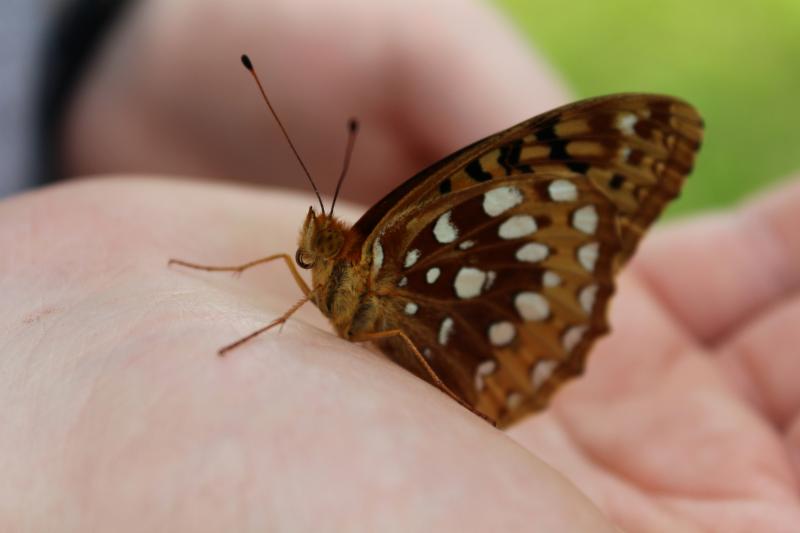
Great Spangled Fritillaries (Speyeria cybele) do not tend to be shy butterflies.
Insects: The Secret to Everything
There's more to attracting wildlife than just the shape of your garden, however. Creating layers of sheltering habitat is essential, but only half of the task, because in order to properly support wildlife, it's necessary to support insects. Certain plants support certain insects: for example much like monarch butterflies rely on milkweeds, you will rarely have fritillary butterflies do more than briefly visit your garden if you don't plant violets, on which nearly all species of fritillary caterpillar rely. Your plant choices drive the food choices available in your garden, and planting non-native species essentially hamstrings attempts to support insects, because very few insect species are able to use non-native plants in their life cycles: native butterflies may enjoy the nectar, but then they'll move on unless there are host plants for their young, giving them a reason to stay. The best way to encourage insects is to plant a biologically diverse variety of native host plants, so that a wide variety of insect species can thrive. But why are insects so important?
In addition to looking pretty, as the butterflies certainly do, insects are a crucial food source for songbirds. You're far more likely to have a variety of birds come to visit you (and possibly nest!) if they have something to eat (and feed their young) in your yard. So in addition to supporting butterflies, a habitat garden also supports moths, caterpillars, bees, praying mantids, ground beetles, and a whole host of other insects on which animal species like birds rely. By creating a habitat garden, you are creating a tiny ecosystem in which all the species support each other, and keep each other in balance. For example, here at Toadshade, when we first established our meadow (a rather large-scale habitat garden, but the same general idea), we suddenly had lots of rabbits at our farm. But as time has gone on, their numbers have gone down to what they should be, because we have hawks and foxes that make use of the habitat as well. The life cycles of most things that use habitat gardens are much shorter, so your biodiversity will grow with your garden, and make your yard rapidly more useful and interesting for all kinds of wildlife, all of which will interact with each other.
What if I Want a Garden with Butterflies, but I Don't Want Bees?
Like any part of an ecosystem, bees will be kept in equilibrium by the rest of the species in your habitat garden, but they are attracted to the same flowers butterflies are. Bees are not aggressive when they're nectaring or collecting pollen: it's the best part of their day, they're happy, very forgiving of being bumped, and perhaps a bit sleepy. What's more, as pollinators, honey bees and native bees alike are critical to the functioning of any ecosystem, large or small.
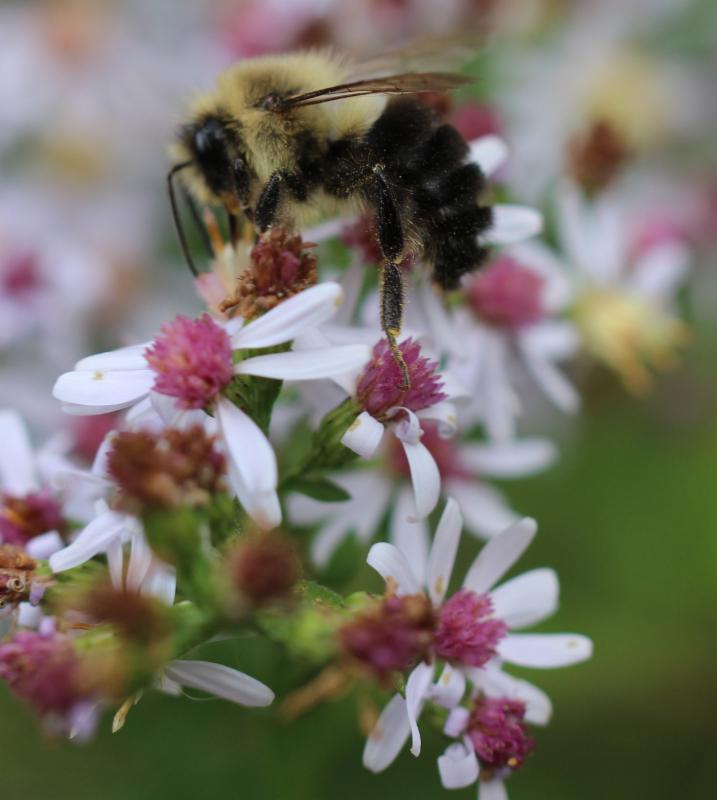
A bumble bee (Bombus sp.) nectaring on Heart-leaved aster (Symphiotrichum cordifolium)
A habitat garden, more than most gardens, will include species which will keep bees in balance, so if you like flowers and butterflies but aren't particularly wild about bees, a habitat garden is the way to go. In order to support pollinators of all types (including both bees and butterflies!) it helps to have flowers blooming over a long period of time, so check the bloom periods of the plants you put in your garden so that you'll be the first one with flowers in the spring, and the last one with flowers in the fall: pollinators of all sorts rely on this! It is also worth noting that we at Toadshade actually actively encourage bees, as all bee species are critical in their ecosystems, and we are happy to report that we've never had a problem with them.
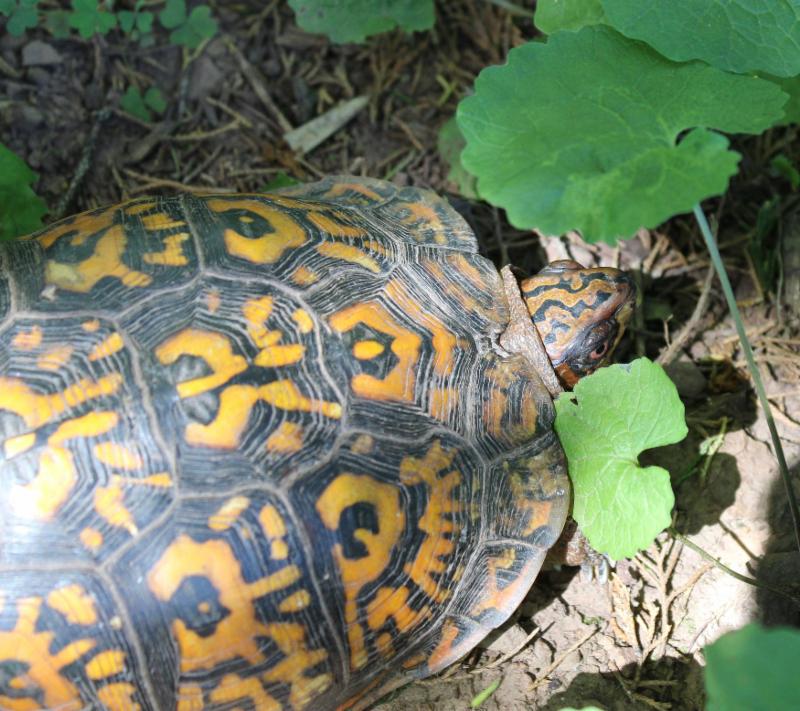
A male box turtle (Terrapene carolina) on leaf litter
Leaf Litter: An Overlooked Gift
High on the list of less-useful things found in most gardens is mulch, and this is triply true for habitat gardens. Sure, it keeps the weeds down and traps moisture in the soil, but not as well as its natural alternative: leaf litter. Mulch only supports ants, termites, slugs, the occasional cricket, and possibly a spider or two. Leaf litter, on the other hand, provides a place for butterfly pupae to potentially overwinter. It gives a place for ladybeetles to live, so that their predatory larvae can eat aphids in the garden. It provides shelter for all the species in your garden and too many insect species to list, and is a natural fertilizer that will noticeably improve the quality of your soil. Yet for some reason every fall we pack it (along all the butterfly pupae we've been trying to encourage) into trash bags and put them on the curb. This year perhaps plan to do something different: if you don't have sufficient groundcover plants yet (which work better than either mulch or leaf litter), use naturally-occurring leaf litter to mulch your garden. The butterflies, your plants, and the whole ecosystem you're trying to encourage in your garden will thank you.
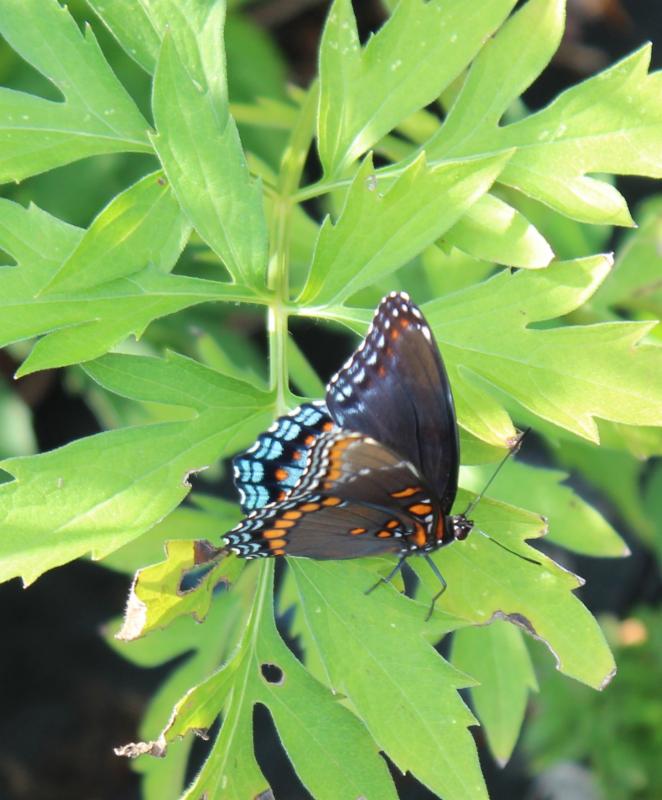
Red-Spotted Purple butterfly (Limentitis arthemis astyanax) on a Tall Coneflower (Rudbeckia lacinata) leaf
The Creation of an Ecosystem
Ultimately how you design your garden is up to you, but remember that when you create a garden, you're not just creating it for yourself! A certain degree of responsibility and stewardship is involved in any garden, because all the birds and insects and animals in your area will be impacted by how you decide to care for your garden. The ever-popular butterfly bushes (which are decidedly non-native: they have origins in Asia) can act as a source of nectar, but they are also invasive, and thereby commonly escape into the environment and replace plants that could actually be useful to wildlife: so not only do they not improve habitat for wildlife, they actively harm it. Research is important! Host plants help insects and butterflies, and by extension birds and other animals, and it all starts with habitat gardens that allow animals like these to thrive. So when you do your research and choose your plants, keep in mind who you could be helping, and just wait till you see who shows up!

